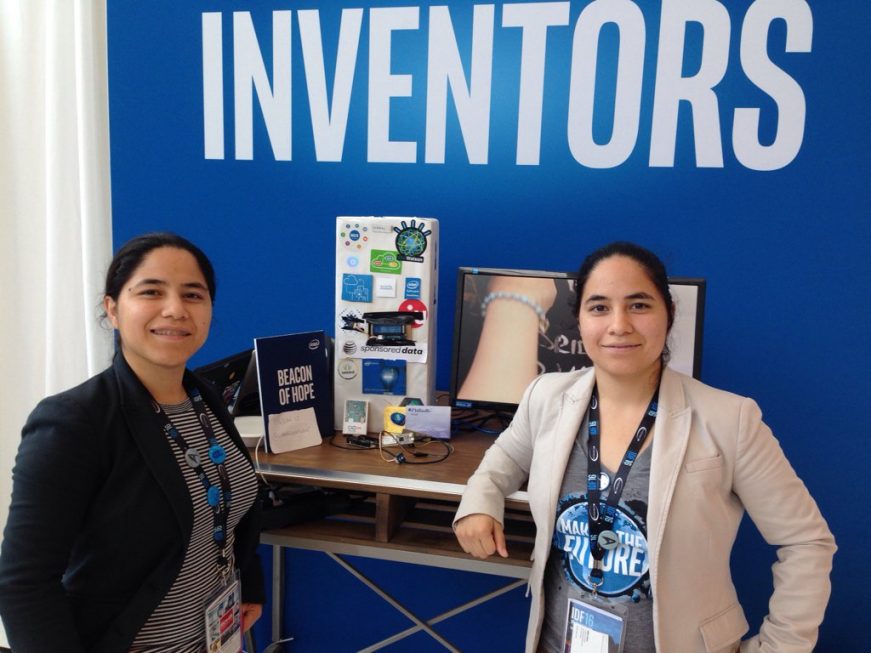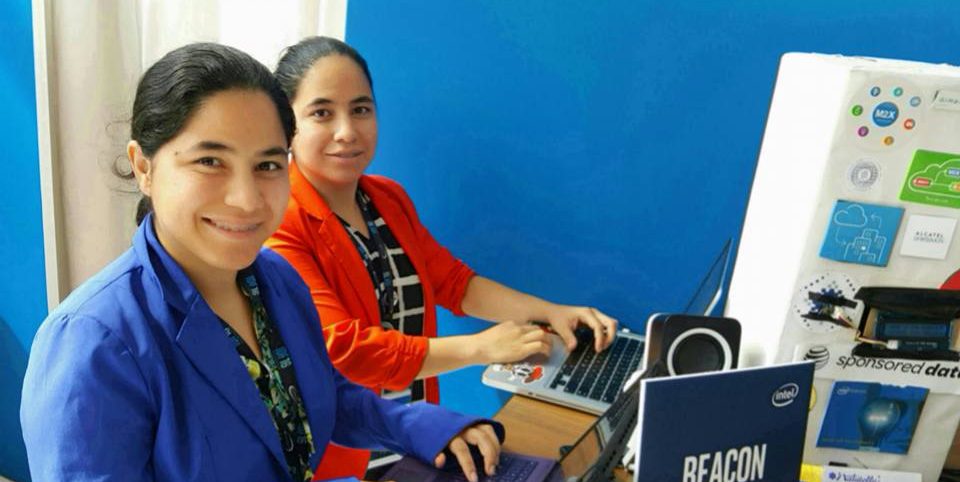This article is part of a collaboration with iQ by Intel.
When their aunt was abducted and traded into a pipeline of human trafficking while crossing the Mexico-US border, sisters America and Penelope Lopez turned to Internet of Things (IoT) technology to find a way to help other women. Human trafficking is a humanitarian crisis that affects nearly 21 million adults and children worldwide, according to recent statistics from the International Labor Organization (ILO). These victims are usually coerced into forced labor or become victims of sexual exploitation. They work for non-existent or slave wages and feel trapped, with seemingly no way out.
America Lopez’s aunt managed to escape her captors by crawling through a bathroom window. “She saw stickers in the bathroom stalls that said ‘call this number for help,’” said America. “But what are the chances of that when you’re guarded so closely?” To help give threatened women a way out, America and Penelope, “The CyberCode Twins,” are developing Beacon of Hope. The device turns a simple tampon or pad into a distress signal.

Beacon of Hope pairs the small size and flexible power of Intel Curie with Bluetooth-enabled trackers that, once activated, can give authorities real-time updates on victims’ whereabouts. The trackers are embedded into tampons and pads, which would be available from dispensers at highway rest stops, gas stations and casinos. At the press of a button, a woman in trouble could get a tracker tampon and carry it in her purse or pocket.
The twins are part of the Intel Software Innovators Program, which helps independent makers bring their ideas to fruition. Their tampon-tracker idea sparked during an Intel-sponsored AT&T Hackathon, and the prototype earned the twins a top-15 finish at IBM’s Global Mobile Innovator Tournament earlier this year. While their prototype is being demoed in tampons or pads, America said trackers could be hidden in any small item, such as a hair tie or a patch. “We really believe in creating solutions,” she said, explaining that she sees this device as one step in the right direction.
“Smart cities should care about the safety of those that are considered vulnerable,” America said. “But the technology to increase women’s safety just isn’t there; it isn’t a priority.” Beacon of Hope is part of a larger movement to show how tech can be used more broadly to combat social problems, including kidnapping and human trafficking. DYI tech platforms like Hackster.io aim to make tech more accessible, and events like Hackster Live enable encourage hackers to address the issues they face every day using IoT tech.
While IoT modules like Edison and Curie include small-area wireless capabilities, there are some tiny compute boards that come with built-in GSM, according to Adam Benzion, co-founder of Hackster.io. This allows devices to connect to wireless networks and send data from almost anywhere there’s a signal. “You can now take technologies that are completely open source and have amazing coverage,” Benzion explained.

WEAR, a low-cost wearable created by a high-school student through Hackster.io, uses Arduino technology on a woman’s wearable device that sends friends and family security alerts at the press of a button. Currently, two out of three assaults in the U.S. go unreported. A new site, Survivors.io provides a map and reporting system for victims of sexual assault worldwide. It lets victims anonymously input when, where and by whom they were assaulted. The site was created by a graduate of AnnieCannons, a non-profit that trains survivors of human trafficking in code so they can secure stable, livable income.
AnnieCannons CEO and cofounder Jessica Hubley said Survivors.io is meant to break down the barriers that prevent sexual assault survivors from going to the police. America added that this kind of technology can also be used for Amber Alerts, refugee centers or domestic violence shelters. “This is a space that needs a lot more innovation,” she said.
